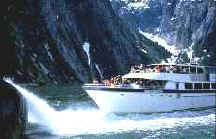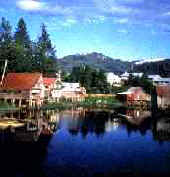SHELTERED SEAS CRUISE
by Geri AndersonHE wants a cruise ship vacation, and the "I can't possibly eat another shrimp" feeling that cruises are made of. SHE would rather bed down in on-shore inns and lodges and get to know the "real" people who live in the area. THEY are arguing about how to best see Alaska's glaciers and grizzlies.

The 55-passenger MS Sheltered Seas gets to those special private spots.
PHOTO CREDIT: GERI ANDERSON
Both HE and SHE can have it their way if they go by Sheltered Seas, an alternative to big-ship cruise travel. Accommodating under 100 people, the "little boats," as passengers fondly call them, are operated by Alaska Sightseeing Cruise West. The only thing little is the size, which allows the captain to maneuver in and out of harbors and narrow waterways that ocean-going vessels can't reach. Also, these smaller ships get closer to the sights and sounds of glaciers as they break off and fall into the headwaters. Plus, the ships can get you a front seat to the "big" shows on shore where bear, elk, moose, Dall sheep and other wild animals take center stage. Because sailing is only in daylight, no animal-in-the-wild act is missed.
My Sheltered Seas vacation went from north to south -- from Juneau to Ketchikan. Megan, ship chieftess, greeted me as I boarded the boat that was to be my home during daylight hours for the next four days. She, and eight young staff members, answered questions, put on skits, and mingled with the passengers during our trip. The ship's three decks, dining room, and bar/lounge area provided ample space to walk about, sit and read, and visit with other passengers.
During the first few hours of our trip, dolphins entertained us as they playfully romped in our wake. It was as if they sent out a signal, "surf's up," to their comrades. We saw eagles perched on the crystal blue tips of icebergs, and moose nibbling bushes on shore.

Petersburg, a picture-perfect fishing village.
PHOTO CREDIT: GERI ANDERSON
All meals during our Sheltered Seas cruise were on-board, except for a home-cooked Norwegian breakfast and an evening buffet in Petersburg, where we spent the first two nights. No large cruise ships can dock in Petersburg, since the picturesque fishing village, backdropped by snow-capped mountain peaks, doesn't have a deep harbor.
Norwegian emigrant, Peter Buschmann, founded the town in 1897. Today, it's known as "Little Norway," because of the Norwegian-American settlers who followed Buschmann to the fertile fishing flats. Fishing is the mainstay of the villagers, who claim it as the salmon fishing capital of the Pacific northwest. The town of 2,500 people has 700 docks, 1,000 fishing boats and four canneries.
After checking into my comfortable room at Tide's Inn, I headed out in search of real folk. Strolling leisurely down Petersburg's main street, with the harbor on one side and small inlets and coves on the other, I photographed mirror images of homes on stilts at water's edge. Colorful rosemaling decorate doors and shutters.
Over a beer at a pizza parlor at the end of town, I learned that many areas in the surrounding 17-million-acre Tongass National Forest are as yet unsurveyed and unexplored. My informant, George, worked for the forest service, a member of the survey crew camped out on barges. Tomorrow was his day off.
Tomorrow, for me, meant a "I can't possibly take another bite," Norwegian breakfast buffet of smoked salmon quiche, scones, pickled herring, raspberry strudel, lefse, cinnamon rolls, Swedish pancakes with rhubarb filling, plus several kinds of homemade breads. The breakfast cooked and served by Petersburg townsfolk earns 5 stars from me.
After breakfast, we boarded our Sheltered Seas roving home and traveled
through Tracey Arm Fjord to LeConte glacier. As we cruised through Tracy Arm, one of
the most scenic waterways in Alaska, a thunderous rock show erupted. Boulders as big
as Volkswagens rolled down a steep hillside. The leading actors in the show looked
like giant meatballs in a boiling stew, as they tumbled the water. Captain Paul took
us as close to the spectacle as he dared.
On this day trip, we didn't leave all of Petersburg behind. Several residents joined us. My favorite Petersburgian, Syd Wright, a bearded and pot-bellied 30-year resident, came aboard with an armful of smudged file boxes, filled with dog-eared letters and news clippings. He educated and entertained us with tales about his life as superintendent of schools in a Tlingit Indian settlement. Then, Syd invited us to peruse his files. There were clippings, letters, and articles about politics, wildlife, and native peoples.
It was early afternoon when we returned to Petersburg. Wright invited us to join Vara, his wife, and himself on their fishing trawler for a catch-of-the-day late luncheon. Six of us paid $88 for Syd and Vara to take us aboard their trawler. We watched, and sometimes helped, as Syd whirled his net into the water. When he hauled it in, minutes later, crab, shrimp, and flounder flopped around, entangled in the net and each other. In the meantime, Vara had the pot boiling in the cabin below.
Cozily seated at the table set with blue place mats and white plates, we savored the just-cooked catch, and washed it down with cold beer and white wine.
As I left Wright's trawler with a "I can't possibly eat another shrimp," feeling, I realized it was almost time for a home-cooked Norwegian buffet at the Sons of Norway Lodge. Built in 1912, the meeting house on stilts in the harbor is a National Historic Site. After a buffet of Norwegian meatballs, salmon slaw, a variety of Scandinavian salads and desserts, children danced for us -- in native costume. Their handmade blue bronards (pleated, high-waisted dresses) are the only ones in the United States officially registered in Norway. Then, the rosy-cheeked youngsters taught us some of their folk dance steps. They posed for pictures in front of the full-size replica of a Viking ship that decorates the exterior of the lodge.
As sad as we were to leave Petersburg and its "Velkommen" hospitality, Wrangell lay ahead, through the Wrangell narrows, too tight for oceangoing vessels to maneuver. In Wrangell, a small fishing port, we visited Chief Shake's Island, site of a native clan tribal house -- full of folklore, totems, and ancient carvings. Fishermen in the harbor, too shallow for deep sea vessels, were scraping off paint from boat bottoms.
After 85 more miles along the inland waterways, where we saw bear and moose on shore, we arrived in Ketchikan. (The large cruise ships had left their docks, so we had the town to ourselves tourist-wise). I wandered about, since it was still daylight. At about 9 p.m., while sipping a mug of beer on a restaurant patio overlooking the harbor, I watched the sunset over the Tongass Mountains. The rounded peaks looked like a caravan of dinosaurs at rest for the night. A few minutes later, a dense fog rolled in from the west, and covered the dozing dinosaurs with a fuzzy gray blanket. The fog crept steadily across the narrows and over the mountains, followed by darkness. My Sheltered Seas vacation had officially ended.
The Sheltered Seas, and other small ships of the Alaska Sightseeing Cruise West are a great choice for travelers who want to cruise, but who also want to explore off-the-beaten-path fishing villages and to mingle with townsfolk. You can choose several fly-and-cruise packages, and select travel options to include sights in Anchorage, Denali National Park, and Fairbanks. For information, call 1-800-426-7702.
